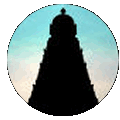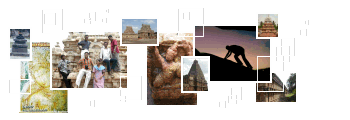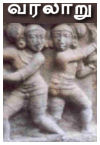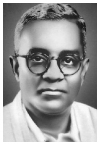 |
 |
 |
http://www.varalaaru.com A Monthly Web Magazine for South Asian History [184 Issues] [1822 Articles] |
 |
 |
 |
http://www.varalaaru.com A Monthly Web Magazine for South Asian History [184 Issues] [1822 Articles] |
|
Issue No. 11

இதழ் 11 [ மே 15 - ஜூன் 14, 2005 ] 
இந்த இதழில்.. In this Issue.. 
|
Gopalakrishna Bharthi’s stay in Anathaandavapuram helped him gain prowess in carnatic music. He sang compositions of yester year composers like Maayuraththammaal1, Papanasa Mudhaliyar2, Periya Thirukkundram Subbarama Iyer3 etc. In Ramadas’s Tutelage As Bharathi’s expertise in carnatic music was growing he also wanted to learn Hindustani music. At that time, Ramadas, a renowned musician with expertise in Hindustani music was living in Thiruvidaimarudhar. Maratha King Amarasimha was his key patron. On hearing about Ramadas, Bharathi visited Thiruvidaimarudhur and requested him to teach Hindustani music. Ramadas was impressed by Bharathi’s Shiva bhakthi and expertise in Carnatic music and readily accepted him as his Sishya. Bharathi’s natural inclination to reach for the roots helped understand the nuances of Hindustani music and to appreciate the beautiful yet different (from Carnatic music) parts of this form. His stint under Ramadas helped him understand the structure of North Indian song in languages like Marathi. Stay In Thiruvidaimarudhur During his stay in Thiruvidaimarudhur, his day would invariably begin with a visit to the Mahalingamurthy temple. After visiting the shrine of Mahalingamurthy, he would perform Ashwamedha Pradhakshanam4. During such times, he has composed a few krithis on Lord Shiva. At that time, Ganam Krishna Iyer5 was the Asthaana Vidwan of Amarasimha Maharaja’s court. His unparalleled proficiency in Gana marga attracted Bharathi towards him. It isn’t a tough task for a musician like Ganam Krishna Iyer to spot the talent in Gopalakrishna Bharathi. Bharathi learned several kirtanas including his own tamil compositions. From then on Bharathi had a special inclination toward Ganam Krishna Iyer’s kirtanas. Bharathi’s adherence to strict discipline enhanced his musical aptitude. In the due course, composing kirtanas were a part of his regular chores. His fame began to spread and musicians from several places like Kumbakonam, Theperumal koil (Thevaiperumal koil) appreciated his kirtana structure. His tunes were apt for singing in concert arena and this brought several musicians to Bharathi for learning his kirtanas. Chidamabara Bhakthi Bharathi was attracted towards Chidambaram right from his childhood. He would visit Chidambaram on all six occasions of the year when the Abhishekam to the dancing Lord Nataraja is performed. His training in Adhvaitha Sastras motivated him to analyze the inner meaning of ‘Chith Sabai’ and philosophy behind Nataraja. He took efforts in the form of meditation (dhyana) and followed niyamas like Pranayama without fail to achieve complete control over the mind. During that time, he composed innumerable kirtanas praising Lord Nataraja. Anandha Bharathiyar Anandha Bharathiyar, a Vaishnavite musician, lived in Thiruvidaimaruthur. He has tuned ‘Bhagavata Dasamaskantham’, ‘Thiruvidaimaruthur Nondi Natakam’ etc. Goplakrishna Bharathi and Ananda Bharathi shared a good friendship and Goplakrishna Bharathi would sing his compositions to Anandha Bharathi and get his feedback. Anandha Bharathi would invariably end up admiring Gopalakrishna Bharathi’s tunes and would praise his kirtana structure. Once, Gopalakrishna Bharathi was singing one of his compositions tuned in Raga Nadanamakriya. It is no wonder that he was totally immersed in the song as it was in praise of his favorite god ‘Nataraja’. Ragam: Nadanamakriya (Pallavi) ini inimElenakkenna vicaaram – irukkudhaiyaa ini inimElenakkenna vicaaram. (Anu Pallavi) panimalai tharu sivakaamiyin nEsaa6 bhaktharkaLukku nankaLikkum visvaasaa thinamu nadampuri njaana prakaasaa thillaiyil vaazum kanaka sabEsaa7 (ini) (Charanam – 1) aasaapaasak kayiRukaLellaam aRuththEn - agaNda miiRum aaRu kuNanguLai8 niiRu niiRaagavE iRuththEn - annamayaathi kOsangkaLaindhaiyum vERu vERaagavE kuRiththEn9 - moolaadhaaraadhi kOddaikkathipathikkaararaik kaNdudal oRuththEn10 - anaadhikarma vaasanaiyaakiya vidhaikaLai vaRuththEn maNdala vaazkaiyaik kaNdu veRuththEn nEsamudanE adiyaarkaLai aduththEn nirvikalpa samaadhiyil thoduththEn11 (Charanam – 2) eppadiyum ennai ratchikkum poRuppunakkirukkum - sandhEgamillai eLLaLavung krubai12 irukkinum manadhai nerukkum - prabanchamellaam soppidu viththaikaLaaduthal pOl bramaiyirukkum - kaRpithamaana13 sOdasa viththaikaLOdavE14 laagiri perukkum - vishayam pOkki eppozuthum15 un thiruvadi paNivEn Ekaakaaramaana uRuthiyai16 aNivEn PaRpala yOsanai yellaan thaNivEn Paramapathang kaNdEnenRu thuNivEn (ini) (Charanam – 3) ERRamudanE Gopalakrishnan nidham17 paadam - thudhikaL seythE EruvEn raajayO kathikaLaana pIdam - samsaarak kadal maaththiraip pozuthilE thaaNdavEthEduvEn Odam - sivalOkam endra vaakkiya baavanaiyaakiya hrudhayaka paadam - visthaaramaana saasthra vEdha puraaNangkaL paarththEn samsayabaavanai mUnRaiyun thIrththEn18 gaaththiram umadhenRu thaaraiyai vaarththEn kanaka sabaapathiyenRunaik kaaththEn. (ini) When Bharathi was deeply absorbed in the song, Anandha Bharathiyar visited him. He requested Gopalakrishna Bharathi to sing the kirtana from the beginning. Goplakrishna Bharathi obliged and started singing the song. The rendition was so moving that it translated all the inner feelings of one Bharathi to another. The tune left such an impact that inspired Anandha Bharathi, who was then composing tunes to “Uththara Ramayanam”, to use this tune for one of his songs. He improvised a little on Gopalakrishna Bharathi’s tune and composed the song “mahi paripaalanam cheythaanE raaman – ayOththi thannil19”. Later, Ariyalur Sadogopa Iyengar used this tune in one of the songs in his book “Ramayana chinthanai”. (Pallavi line of thast song is “unadharul mahimaiyai yaadhenRE solvEn – udhavaa vazhi pulvEn”. There are several incidents similar to this where Gopalakrishna Bharathi’s songs have won acclaim from fellow musicians and inspired his contemporary composers. Footnotes ( All the points in this footnote are U.Ve.Sa’s): 1. MayuraththammaaL lived a few centuries ago. She has composed several kirtanas, strictly adhering to carnatic ragas. Her compositions are based on the principles of adhvaitha sastra and were popular among adhvaitha scholars. She was blessed with grace of Godess Abhayambikai. Her descendants still live in medavaLaagam of the Maayuram Temple. 2. Papanasa Mudhaliyar has composed several kirtanas and literary works like KumbEsar kuRavanji. 3. Periya ThirukkunRam Subbarama Iyer has composed several kirtanas and was the elser brother of Ganam Krishna Iyer. 4. Performing Pradhakshnam of the outer Prahara of Thiruvidaimarudhur Mahalingaswamy temple is called aswamEdha pradhakshanam. Aswamedha pradhakshanam was performed to recover from chronic diseases, mental ailment, dhoshas caused by ghosts and grahas. 5. Life history of Ganam Krishna Iyer has been published separately. (footnotes 6-8 are list of variations in the song (paada bedham)) 6. ‘Panimalai tharum umai sivakaami nEsaa’ 7. ‘Thenpuliyur’ 8. ‘nIRu pOlagavE’ 9. ‘piriththEn’ 10. ‘kaNdu kaN kaLiththEn’ 11. ‘PaduththEn’ 12. ‘eLLaLavung kirubaiyaakilu manathinilirukkum’ 13. ‘kaRpanaiyaana’ 14. ‘viruththikaL’ 15. ‘eppadiyum’ 16. ‘Ekaakkiramaana uRudhiyai’ 17. ‘paadum’ 18. ‘thORREn’ |

சிறப்பிதழ்கள் Special Issues 

புகைப்படத் தொகுப்பு Photo Gallery 
|
| (C) 2004, varalaaru.com. All articles are copyrighted to respective authors. Unauthorized reproduction of any article, image or audio/video contents published here, without the prior approval of the authors or varalaaru.com are strictly prohibited. | ||